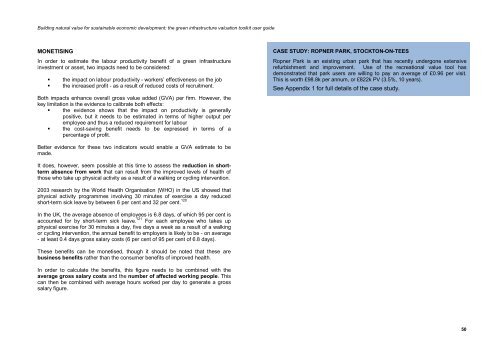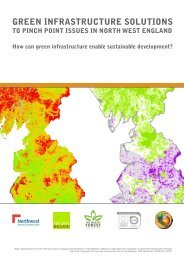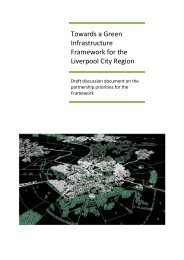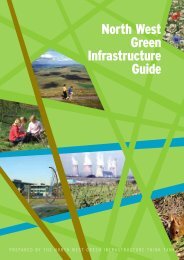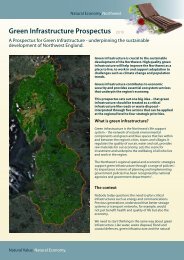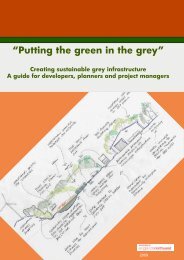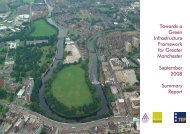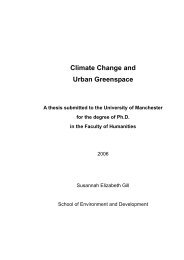The green infrastructure valuation toolkit user guide
The green infrastructure valuation toolkit user guide
The green infrastructure valuation toolkit user guide
Create successful ePaper yourself
Turn your PDF publications into a flip-book with our unique Google optimized e-Paper software.
Building natural value for sustainable economic development: the <strong>green</strong> <strong>infrastructure</strong> <strong>valuation</strong> <strong>toolkit</strong> <strong>user</strong> <strong>guide</strong><br />
MONETISING<br />
In order to estimate the labour productivity benefit of a <strong>green</strong> <strong>infrastructure</strong><br />
investment or asset, two impacts need to be considered:<br />
<br />
<br />
the impact on labour productivity - workers’ effectiveness on the job<br />
the increased profit - as a result of reduced costs of recruitment.<br />
Both impacts enhance overall gross value added (GVA) per firm. However, the<br />
key limitation is the evidence to calibrate both effects:<br />
the evidence shows that the impact on productivity is generally<br />
positive, but it needs to be estimated in terms of higher output per<br />
employee and thus a reduced requirement for labour<br />
the cost-saving benefit needs to be expressed in terms of a<br />
percentage of profit.<br />
CASE STUDY: ROPNER PARK, STOCKTON-ON-TEES<br />
Ropner Park is an existing urban park that has recently undergone extensive<br />
refurbishment and improvement. Use of the recreational value tool has<br />
demonstrated that park <strong>user</strong>s are willing to pay an average of £0.96 per visit.<br />
This is worth £98.8k per annum, or £822k PV (3.5%, 10 years).<br />
See Appendix 1 for full details of the case study.<br />
Better evidence for these two indicators would enable a GVA estimate to be<br />
made.<br />
It does, however, seem possible at this time to assess the reduction in shortterm<br />
absence from work that can result from the improved levels of health of<br />
those who take up physical activity as a result of a walking or cycling intervention.<br />
2003 research by the World Health Organisation (WHO) in the US showed that<br />
physical activity programmes involving 30 minutes of exercise a day reduced<br />
short-term sick leave by between 6 per cent and 32 per cent. 120<br />
In the UK, the average absence of employees is 6.8 days, of which 95 per cent is<br />
accounted for by short-term sick leave. 121 For each employee who takes up<br />
physical exercise for 30 minutes a day, five days a week as a result of a walking<br />
or cycling intervention, the annual benefit to employers is likely to be - on average<br />
- at least 0.4 days gross salary costs (6 per cent of 95 per cent of 6.8 days).<br />
<strong>The</strong>se benefits can be monetised, though it should be noted that these are<br />
business benefits rather than the consumer benefits of improved health.<br />
In order to calculate the benefits, this figure needs to be combined with the<br />
average gross salary costs and the number of affected working people. This<br />
can then be combined with average hours worked per day to generate a gross<br />
salary figure.<br />
50


